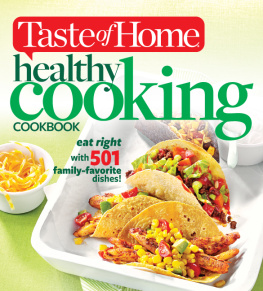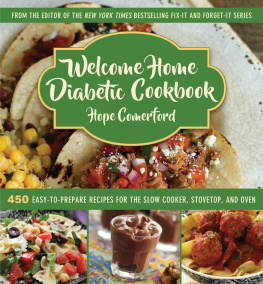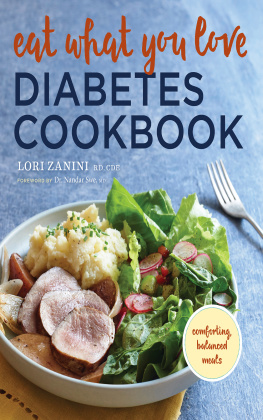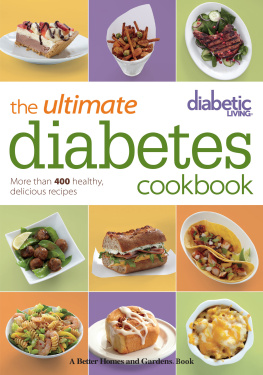 A TASTE OF HOME/READERS DIGEST BOOK 2014 RDA Enthusiast Brands, LLC 1610 N. 2nd St., Suite 102, Milwaukee WI 53212-3906 All rights reserved. Taste of Home and Readers Digest are registered trademarks of The Readers Digest Association, Inc. EDITORIAL Editor-in-Chief: Catherine Cassidy Creative Director: Howard Greenberg Editorial Operations Director: Kerri Balliet Managing Editor, Print & Digital Books: Mark Hagen Associate Creative Director: Edwin Robles Jr. Editors: Heather Ray, Janet Briggs, Michelle Rozumalski Associate Editors: Molly Jasinski, Christine Rukavena Contributing Layout Designer: Dit Rutland Editorial Production Manager: Dena Ahlers Copy Chief: Deb Warlaumont Mulvey Copy Editor: Mary C. Hanson Content Operations Manager: Colleen King Content Operations Assisstant: Shannon Stroud Executive Assistant: Marie Brannon Chief Food Editor: Karen Berner Food Editors: James Schend; Peggy Woodward, RD Recipe Editors: Mary King; Annie Rundle; Jenni Sharp, RD; Irene Yeh Test Kitchen & Food Styling Manager: Sarah Thompson Test Cooks: Nicholas Iverson (lead), Matthew Hass, Lauren Knoelke Food Stylists: Kathryn Conrad (senior), Leah Rekau, Shannon Roum Prep Cooks: Megumi Garcia, Melissa Hansen, Bethany Van Jacobson, Sara Wirtz Photography Director: Stephanie Marchese Photographers: Dan Roberts, Jim Wieland Photographer/Set Stylist : Grace Natoli Sheldon Set Stylists: Stacey Genaw, Melissa Haberman, Dee Dee Jacq Editorial Business Analyst: Kristy Martin BUSINESS Vice President, Chief Sales Officer: Mark Josephson Vice President, Business Development & Marketing: Alain Begun General Manager, Taste of Home Cooking Schools: Erin Puariea Vice President, Digital Experience & E-Commerce: Jennifer Smith THE READERS DIGEST ASSOCIATION, INC.
A TASTE OF HOME/READERS DIGEST BOOK 2014 RDA Enthusiast Brands, LLC 1610 N. 2nd St., Suite 102, Milwaukee WI 53212-3906 All rights reserved. Taste of Home and Readers Digest are registered trademarks of The Readers Digest Association, Inc. EDITORIAL Editor-in-Chief: Catherine Cassidy Creative Director: Howard Greenberg Editorial Operations Director: Kerri Balliet Managing Editor, Print & Digital Books: Mark Hagen Associate Creative Director: Edwin Robles Jr. Editors: Heather Ray, Janet Briggs, Michelle Rozumalski Associate Editors: Molly Jasinski, Christine Rukavena Contributing Layout Designer: Dit Rutland Editorial Production Manager: Dena Ahlers Copy Chief: Deb Warlaumont Mulvey Copy Editor: Mary C. Hanson Content Operations Manager: Colleen King Content Operations Assisstant: Shannon Stroud Executive Assistant: Marie Brannon Chief Food Editor: Karen Berner Food Editors: James Schend; Peggy Woodward, RD Recipe Editors: Mary King; Annie Rundle; Jenni Sharp, RD; Irene Yeh Test Kitchen & Food Styling Manager: Sarah Thompson Test Cooks: Nicholas Iverson (lead), Matthew Hass, Lauren Knoelke Food Stylists: Kathryn Conrad (senior), Leah Rekau, Shannon Roum Prep Cooks: Megumi Garcia, Melissa Hansen, Bethany Van Jacobson, Sara Wirtz Photography Director: Stephanie Marchese Photographers: Dan Roberts, Jim Wieland Photographer/Set Stylist : Grace Natoli Sheldon Set Stylists: Stacey Genaw, Melissa Haberman, Dee Dee Jacq Editorial Business Analyst: Kristy Martin BUSINESS Vice President, Chief Sales Officer: Mark Josephson Vice President, Business Development & Marketing: Alain Begun General Manager, Taste of Home Cooking Schools: Erin Puariea Vice President, Digital Experience & E-Commerce: Jennifer Smith THE READERS DIGEST ASSOCIATION, INC.
President and Chief Executive Officer: Bonnie Kintzer Vice President, Chief Operating Officer, North America: Howard Halligan Vice President, Enthusiast Brands, Books & Retail: Harold Clarke Vice President, North American Operations: Philippe Cloutier Chief Marketing Officer: Leslie Dukker Doty Vice President, Brand Marketing: Beth Gorry Vice President, North American Human Resources: Phyllis E. Gebhardt, SPHR Vice President, Consumer Marketing Planning: Jim Woods Cooking, Caring, Sharing is a registered trademark of RDA Enthusiast Brands, LLC. For other Taste of Home books and products, visit us at tasteofhome.com. For more Readers Digest products and information, visit rd.com (in the United States) or rd.ca (in Canada). International Standard Book Number (Epub): 978-1-61765-267-7 Cover Photography: Taste of Home Photo Studio Pictured on front cover:
Contents
Contents

UNDERSTANDING DIABETES
What is it?
Our bodies require insulin to help get glucose into our cells for energy. When you have diabetes, your body is either not producing enough insulin to feed your cells or cells are resisting the insulin.
When this happens, the level of glucose rises in the blood, leading to a variety of dangerous consequences.
Different Types
Type 1 diabetes occurs when the bodys immune system destroys the cells in the pancreas that produce insulin. Thats why people with Type 1 diabetes take insulin shots or use an insulin pump. Type 2 diabetes occurs when your cells begin to resist the insulin your pancreas produces. Healthy eating, physical activity and regular blood glucose testing are the main therapies for Type 2 diabetes. Untreated, high blood glucose can cause nerve damage, kidney or eye problems, heart disease and stroke, so its important to talk to your doctor about whether you should be actively checking your blood glucose levels.
The key to successfully managing diabetes is to control blood sugar while getting the right amount of nutrients. And that starts with a healthy diet. Each of the 514 recipes in this book has been analyzed to offer you Nutrition Facts and Diabetic Exchanges, so you can choose the best recipes for you and your family.
HOW WE CALCULATE NUTRITION FACTS
When a choice of ingredients is given in a recipe (such as 1/3 cup sour cream or plain yogurt), the first ingredient listed is always the one calculated in the Nutrition Facts. When a range is given for an ingredient (such as 2 to 3 teaspoons), we calculate the first amount given. Only the amount of marinade absorbed during preparation is calculated.
Optional ingredients are not included in calculations.
DIABETIC EXCHANGES
A helpful tool in making smart food choices is the food-exchange system, which organizes foods into several groupsgenerally breads and starches, fruits, vegetables, milk, meat and protein-based substitutes, fats, and other carbohydrates such as sweets. The idea behind the exchange system is that every item within a category is nutritionally equivalent to every other item on that same list, providing roughly the same amount of carbohydrate, fat, protein and calories. While Diabetic Exchanges are designed for people with diabetes, they can also be valuable for anyone trying to control calories, reduce fat and eat a balanced diet. Diabetic Exchanges are assigned to recipes in accordance with guidelines from the American Diabetic Association and the Academy of Nutrition and Dietetics.
RANGES OF EXCHANGES
Some exchange lists are subdivided into groups that specify exchanges of, say, lean meats and substitutes (separate from high-fat meats), or fat-free milk products (separate from whole-milk products).
RANGES OF EXCHANGES
Some exchange lists are subdivided into groups that specify exchanges of, say, lean meats and substitutes (separate from high-fat meats), or fat-free milk products (separate from whole-milk products).
Foods within each category are nutritionally equivalent in the exchange system. STARCHES 1 slice bread 1/2 cup cooked lentils 1/3 cup cooked pasta 1/2 cup corn 1 small potato VEGETABLES 1/2 cup cooked carrots 1/2 cup cooked green beans 1 cup raw radishes 1 cup raw salad greens 1 large tomato FRUITS 1 small banana 1/2 large pear 17 small grapes 2 tablespoons raisins 1/2 cup fruit cocktail FAT-FREE AND LOW-FAT MILKS 1 cup skim or 1% milk 1 cup plain nonfat yogurt 2/3 cup low-fat fruit-flavored yogurt 2/3 cup evaporated nonfat milk 1 cup low-fat buttermilk LEAN MEATS AND SUBSTITUTES 1 ounce skinless chicken breast 1 ounce canned tuna (in water or oil, drained) 1 ounce cheese with 3 grams of fat or less per ounce 1/4 cup low-fat cottage cheese 2 egg whites FATS 1 teaspoon oil 1 teaspoon stick butter 1 1/2 teaspoons peanut butter 1 tablespoon reduced-fat margarine spread 1 tablespoon reduced-fat mayonnaise 6 almonds 4 1/2 teaspoons reduced fat cream cheese 
HEY, THATS NOT TRUE...
3 Myths Worth Busting
People with diabetes have to eat different meals and snacks from the rest of the family. MYTH Its true that family members with diabetes have to watch what they eat, but theres no need to cook separate dishes. Everyone will benefit from eating more leafy greens, high-fiber foods and lean proteins. People with diabetes cant eat sweets or desserts . MYTH Almost everyone has a hankering for something sweet from time to time.
A good way to deal with a food craving is to enjoy a little taste. Having a very small portion on special occasions will prevent you from feeling deprived so you can keep focusing on healthful foods. People with diabetes shouldnt eat starchy foods. MYTH Everyone needs carbohydrates for energy. Whole grains and starchy vegetables like potatoes, yams, peas and corn can be included in meals and snacks, but portion size is key. According to the American Diabetes Association, a good place to start is to aim for 45-60 grams of carbohydrate per meal or 3-4 servings of carbohydrate-containing foods.
Next page










 A TASTE OF HOME/READERS DIGEST BOOK 2014 RDA Enthusiast Brands, LLC 1610 N. 2nd St., Suite 102, Milwaukee WI 53212-3906 All rights reserved. Taste of Home and Readers Digest are registered trademarks of The Readers Digest Association, Inc. EDITORIAL Editor-in-Chief: Catherine Cassidy Creative Director: Howard Greenberg Editorial Operations Director: Kerri Balliet Managing Editor, Print & Digital Books: Mark Hagen Associate Creative Director: Edwin Robles Jr. Editors: Heather Ray, Janet Briggs, Michelle Rozumalski Associate Editors: Molly Jasinski, Christine Rukavena Contributing Layout Designer: Dit Rutland Editorial Production Manager: Dena Ahlers Copy Chief: Deb Warlaumont Mulvey Copy Editor: Mary C. Hanson Content Operations Manager: Colleen King Content Operations Assisstant: Shannon Stroud Executive Assistant: Marie Brannon Chief Food Editor: Karen Berner Food Editors: James Schend; Peggy Woodward, RD Recipe Editors: Mary King; Annie Rundle; Jenni Sharp, RD; Irene Yeh Test Kitchen & Food Styling Manager: Sarah Thompson Test Cooks: Nicholas Iverson (lead), Matthew Hass, Lauren Knoelke Food Stylists: Kathryn Conrad (senior), Leah Rekau, Shannon Roum Prep Cooks: Megumi Garcia, Melissa Hansen, Bethany Van Jacobson, Sara Wirtz Photography Director: Stephanie Marchese Photographers: Dan Roberts, Jim Wieland Photographer/Set Stylist : Grace Natoli Sheldon Set Stylists: Stacey Genaw, Melissa Haberman, Dee Dee Jacq Editorial Business Analyst: Kristy Martin BUSINESS Vice President, Chief Sales Officer: Mark Josephson Vice President, Business Development & Marketing: Alain Begun General Manager, Taste of Home Cooking Schools: Erin Puariea Vice President, Digital Experience & E-Commerce: Jennifer Smith THE READERS DIGEST ASSOCIATION, INC.
A TASTE OF HOME/READERS DIGEST BOOK 2014 RDA Enthusiast Brands, LLC 1610 N. 2nd St., Suite 102, Milwaukee WI 53212-3906 All rights reserved. Taste of Home and Readers Digest are registered trademarks of The Readers Digest Association, Inc. EDITORIAL Editor-in-Chief: Catherine Cassidy Creative Director: Howard Greenberg Editorial Operations Director: Kerri Balliet Managing Editor, Print & Digital Books: Mark Hagen Associate Creative Director: Edwin Robles Jr. Editors: Heather Ray, Janet Briggs, Michelle Rozumalski Associate Editors: Molly Jasinski, Christine Rukavena Contributing Layout Designer: Dit Rutland Editorial Production Manager: Dena Ahlers Copy Chief: Deb Warlaumont Mulvey Copy Editor: Mary C. Hanson Content Operations Manager: Colleen King Content Operations Assisstant: Shannon Stroud Executive Assistant: Marie Brannon Chief Food Editor: Karen Berner Food Editors: James Schend; Peggy Woodward, RD Recipe Editors: Mary King; Annie Rundle; Jenni Sharp, RD; Irene Yeh Test Kitchen & Food Styling Manager: Sarah Thompson Test Cooks: Nicholas Iverson (lead), Matthew Hass, Lauren Knoelke Food Stylists: Kathryn Conrad (senior), Leah Rekau, Shannon Roum Prep Cooks: Megumi Garcia, Melissa Hansen, Bethany Van Jacobson, Sara Wirtz Photography Director: Stephanie Marchese Photographers: Dan Roberts, Jim Wieland Photographer/Set Stylist : Grace Natoli Sheldon Set Stylists: Stacey Genaw, Melissa Haberman, Dee Dee Jacq Editorial Business Analyst: Kristy Martin BUSINESS Vice President, Chief Sales Officer: Mark Josephson Vice President, Business Development & Marketing: Alain Begun General Manager, Taste of Home Cooking Schools: Erin Puariea Vice President, Digital Experience & E-Commerce: Jennifer Smith THE READERS DIGEST ASSOCIATION, INC.
